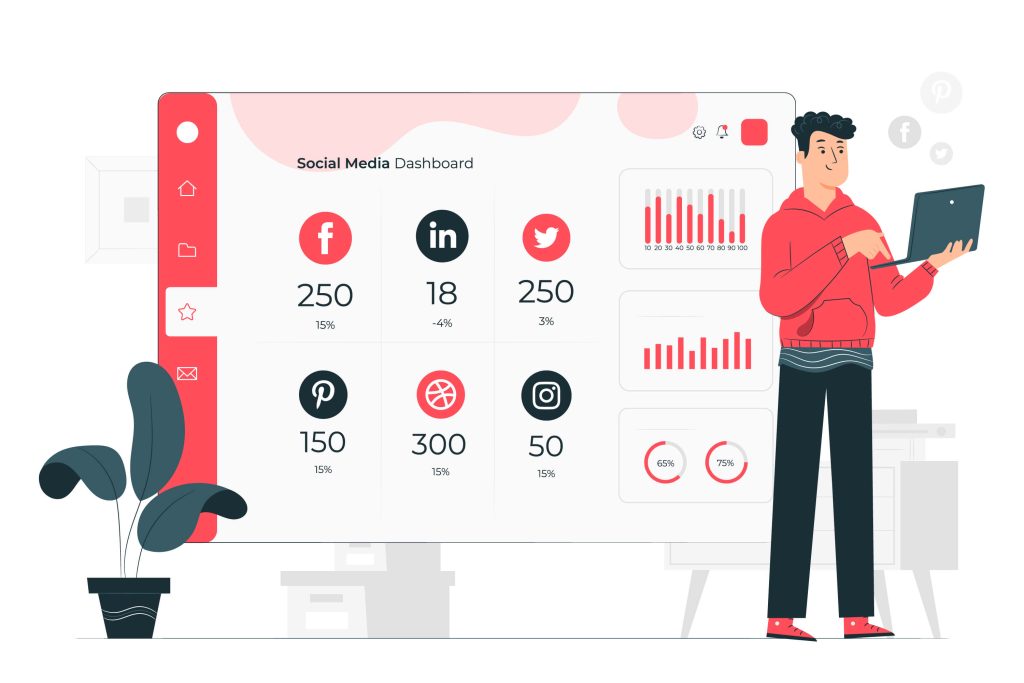Table of Content
1. What is a Social Media Audit?
A social media audit is a comprehensive evaluation of a business’s social media presence, strategies, and activities. The goal is to understand what is currently working well and identify areas that need improvement.

The key elements of a social media audit typically include:
- Analyzing social media platforms and accounts to review content, engagement, followers, etc.
- Collecting and assessing metrics like follower growth, engagement rates, clicks, and conversions
- Researching competitors’ social media activity
- Comparing social media performance to business goals
- Evaluating social media campaigns and paid advertising results
- Assessing strengths to build on and weak areas to improve
- Creating an audit report to summarize findings and provide recommendations
- Developing an action plan for optimizing social media presence moving forward
Regular social media audits help guide strategy, increase efficiency, and maximize the impact of social media efforts. They provide data-driven insights to help businesses improve their presence.
2. How to do a Social Media Audit in 10 steps

Auditing your social media presence regularly is crucial. A social media audit helps identify what’s working and what needs improvement. This guide provides a checklist to conduct your own audits. Follow it for actionable insights.
2.1 Set Goals
Clearly define what you want to accomplish through your social media presence. Setting goals gives your audit focus and helps you shape audit activities. Goals could include growing followers, increasing engagement, driving website traffic, generating conversions, or improving brand awareness. Know your reasons for auditing before diving in.
2.2 Gather Data
Collect key analytics data from each social platform to inform your audit. Use free analytics tools provided by the platforms or invest in paid software to download reports. Gather info on followers, engagement rates, clicks, traffic, conversions, and any other important metrics. Solid data is crucial for insightful auditing.
2.3 Review Content Strategy
Take a deep look at your current social media content mix. Analyze which content topics, formats, styles, and schedules perform best and worst. Evaluate engagement rates and reach for different content types. Look for patterns in top and bottom content to identify strategic changes to your plan.
2.4 Check SEO Optimization
Audit how optimized your social content is for driving organic search traffic. Look at use of relevant keywords, metadata, alt text, captions, tags and other optimization elements. See where there are opportunities to improve to attract more search traffic.
2.5 Assess Ads and Campaigns
Examine any paid advertising or campaigns across each social platform. Calculate cost per click, conversion rates, and return on ad spend. Identify the highest performing creatives, target audiences and placements to guide future paid efforts.
2.6 Look at Competition

Research what competitors in your niche are doing with their social media presence. Compare their follower counts, engagement levels, content strategies and conversations. See where competitors are outperforming you and vice versa. Use these insights to refine your own strategy.
2.7 Evaluate Metrics Against Goals
Review how your social media metrics stack up against the concrete goals you outlined initially. Identify shortfalls in followers, engagement, or conversions needing work. Spot metrics that exceed goals to double down on strengths. Base recommendations on data-driven gaps between goals and reality.
2.8 Find Quick Wins
Brainstorm some quick, small changes you can immediately make for improvement. Look for low-hanging fruit updates like refreshing old ad creatives, fixing landing pages, starting a new video series, or optimizing link profiles. Quick wins build momentum.
2.9 Create an Audit Report
Compile your audit findings into an executive report document. Summarize current performance, opportunities, strengths, weaknesses, and quick wins. Include visual charts and graphs to showcase data. A polished report illustrates insights and priorities. Share it with internal stakeholders.
2.10 Build an Audit Action Plan
Use the audit insights to shape a prioritized action plan for change. Outline specific next steps to address your biggest weaknesses and threats. But also continue building on strengths. Having an actionable plan is key to driving real optimization.
Conducting routine social media audits gives you the full picture. Follow this expanded checklist to get started optimizing your presence.
3. Conclusion
Conducting regular social media audits may seem daunting. However, it’s one of the most valuable investments in your marketing strategy.
While the checklist provides a solid framework, don’t let perfection stall progress. Start with quick wins and go from there.
Focus on incremental improvements over time. With a commitment to keep optimizing, your social media presence and impact on business goals will steadily improve. Be patient, be consistent, and give your team the insights needed to excel on social media. The effort will pay dividends in the long run.
4. FAQs
What is a social media audit?
A social media audit comprehensively analyzes a company’s social media presence, strategies, and activities to identify strengths, weaknesses, opportunities, and next steps.
What is a social media audit, and why is it important?
A social media audit evaluates all aspects of a company’s social media efforts to optimize strategies, increase efficiency, and maximize impact. Regular audits are essential for guiding the process.
How to do a complete social media audit?
Conducting a complete social media audit involves
- setting goals,
- gathering metrics data,
- analyzing content and SEO,
- reviewing ads and campaigns,
- examining competitors,
- assessing against goals,
- finding quick wins and
- creating an action plan.
What is an example of a social audit?
An example social media audit analyzes follower growth, engagement rates, lead generation, web traffic, competitive benchmarking, paid ad results, and platform-specific performance to strategize improvement.

Leave a Reply